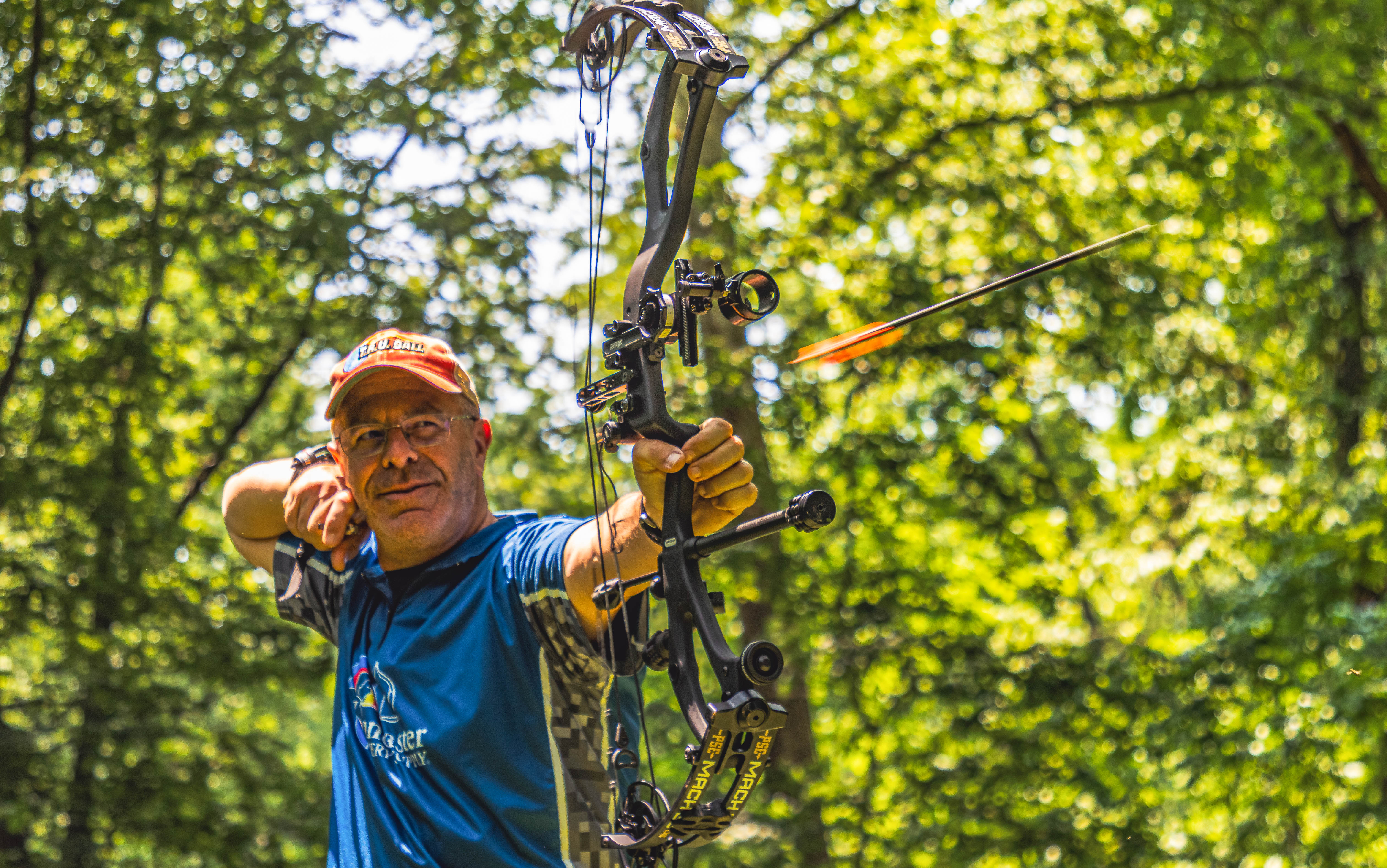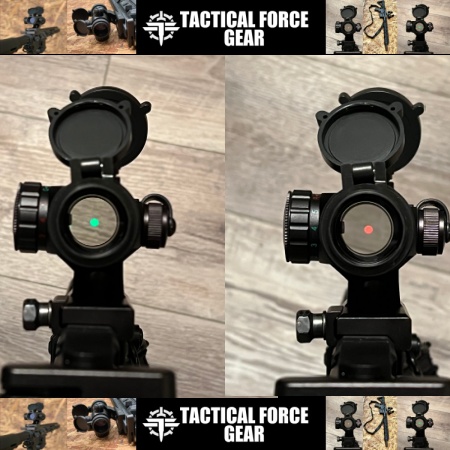We may earn revenue from the products available on this page and participate in affiliate programs. Learn More ›
The truth is, you could grab any of the new flagship bows and be successful.
But the goal of the Outdoor Life bow test is to determine which of the many good bows out there is the best. To do that we put nine top compound bows in a head-to-head test. They were all set up identically and tuned to a bullet hole. Then three different archers shot groups with them at 50 yards. The total arrow count for accuracy testing was 324 shots, which was followed up with hundreds more while evaluating features and shooting characteristics.
Even though the three test team members vary in their bow preferences and shooting experience, they all came to the same conclusion: the PSE Mach 33 DS is the best compound bow of 2025. It has a smooth draw, a comfortable back wall, little vibration after the shot, steady aim, repeatable grip, and, through a bit of engineering wizardry, it makes your bad shots still hit the middle.
This is the second year in a row PSE was the undisputed winner at the end of testing. It had a lot of competition from more innovative and feature-rich designs, but even though those bows are good, the Mach 33 DS is better.
Bows Tested
Jump To
How to Use this Buying Guide
This annual article is a review, but it’s also a buying guide. I want to give you as much information as possible so you can narrow your search to a handful of bows to try out yourself. Here’s a quick guide on the data provided.
Click here for a full breakdown of the testing protocol.
Bow Accessories
All bows were set up with QAD arrow rests and HHA Nytrx Sights. We shot factory fletched Easton 5.0 arrows.
Accuracy
We shot six arrow groups at 50 yards and each tester measured two groups for each bow. A total of six groups for each bow get averaged. You’ll find the average group in the test results section for all the bow reviews.
Scores
We score bows from 1 to 5 on accuracy, innovation, features, back wall, draw cycle, grip, and post shot. A 5 means a bow was the best of a particular category, a 3 is average, and a 2 or 1 means it was a poor performer relative to the field.
Total Score: The scores for each category were averaged and then totaled. A perfect score (all 5s) would be 35 points, and this year’s top score was a 27.3 (PSE Mach 33 DS). You’ll see the total score for each bow in the test results section.
Fore Draw Curves
Think of a draw cycle like a rocking chair. The rocker can be shaped in a way so that the rock starts easy, has its peak in the middle, and then finishes easy. Or it can be shaped so that the beginning requires a little more force and then the end of the rock is much easier. The location of the peak and the shape of the curve changes the experience. A force draw curve is a visual depiction of the rocking chair’s rocker. It’s done by recording draw weight every inch of draw from brace height to the back wall. Then it’s plotted on a line graph.
Speed
All bows were chronographed using a Garmin Xero C1 and a 395 grain Easton 5.0. Bows were set at 60 pounds (+/- 1 pound) and a 29.5-inch draw length.
Tuning Notes
The tuning notes section is meant to give you a starting point on center shot and nocking point height for tuning your bow as well as some insight into nock fit. It’s worth mentioning that there were no big surprises in paper tuning the bows and nearly all tuned close to a 13/16 inch center shot and level or slightly high nocking point.
Editor’s Choice, Best Overall: PSE Mach 33 DS
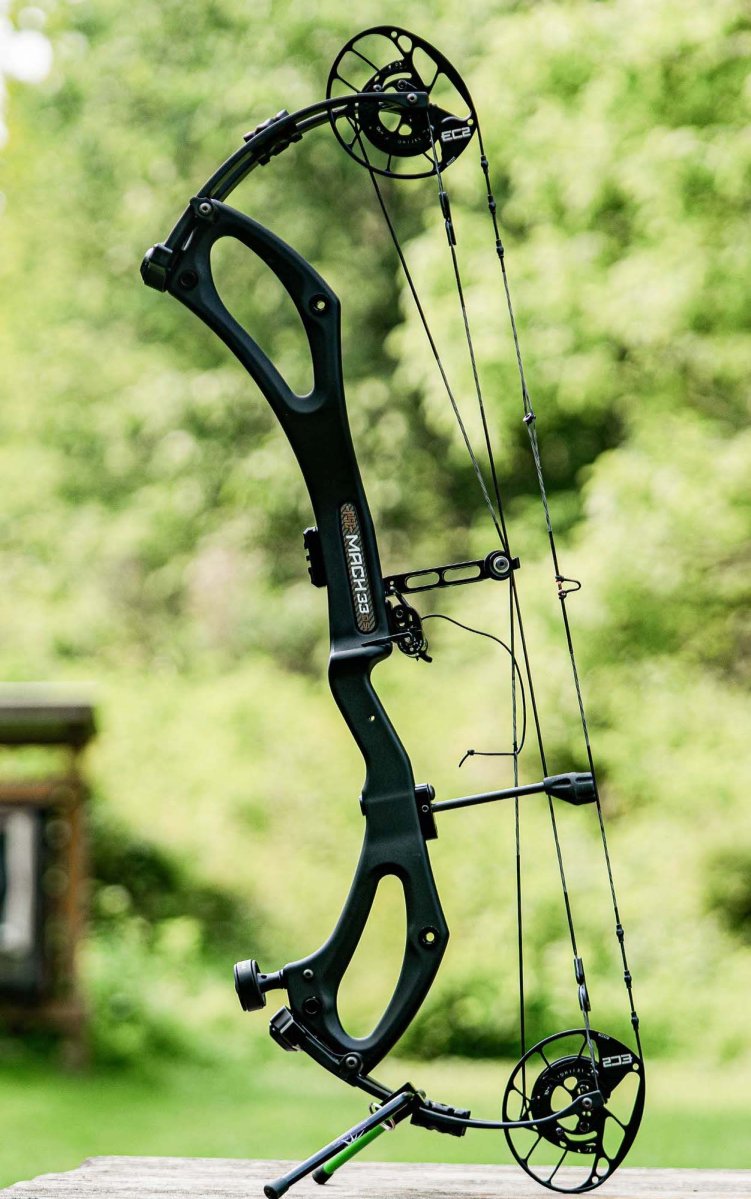
Photo by Derek Horner
See It
Specs
-
Price:
$1,889 -
Draw Length Range:
25.5 to 31 inches (rotating mod) -
Axle to Axle:
33 inches -
Brace Height:
6 ⅝ inches -
Let Off:
80 to 90 percent -
Weight:
4.2 pounds (with QAD arrow rest)
Features
-
Picatinny sight mount -
Hamskea COR and QAD Integrate arrow rest mounts -
EZ.220 cam spacers -
Dead Frequency Carbon riser -
Full Draw Stability: Adds .43-inches of brace height at full draw for reduced torque
Test Results
-
Group Average:
3.37 inches -
Speed:
282 fps (59 pounds) -
Score:
27.3
Tuning Notes
-
Center Shot:
13/16 inch -
Nocking Point Height:
Level -
Stock Serving Diameter:
0.120 inch -
A half twist in the cables yielded a small adjustment in timing
When the scoring was finalized and all the groups measured, I asked each tester what bow they would buy with an unlimited budget. They all said the PSE Mach 33. We still had to input the results into the spreadsheet, but it didn’t take a crystal ball to know who would win.
The PSE Mach 33 DS had the lowest score for innovation and a median score for features. Yet, its shooting characteristics pushed it to the top of the five-foot test. The PSE Decree squeaked ahead of the Mach 33 in accuracy and both bows had substantially smaller group averages than the rest of the field.
Last year, the Mach 30 DS blew us away by being a bow that on paper seems unforgiving, but consistently shot small groups. The key to PSE’s two year accuracy winning streak is Full Draw Stability, which increases dynamic brace height. The Mach 33 has a 6.625-inch brace height, but at full draw, its brace height is just over 7 inches. Basically that means the bow is going to hold steadier and be more forgiving.
In addition to Full Draw Stability, the PSE bows seem to have cracked the code on riser-to-limb length ratio, pivot point location, riser rigidity, repeatable grip, and an overall torque-free platform. The result is a bow that is easy to hold on target and doesn’t punish you as much for making small mistakes.

The archers were also more comfortable shooting the Mach 33 versus other bows because of its smooth draw and nice back wall. It was the top scorer in both those categories. The Mach 33 feels much lighter than its actual draw weight. You can see from its draw force curve that it slowly builds up to the peak weight, maintains peak weight through the middle of the draw, and then slowly drops down in draw weight until you hit the wall. You’d typically expect a bow with that type of draw cycle to be slow, but the Mach 33 was still fast at 282 fps with a 395-grain arrow.
My initial tuning and set up of the Mach 33 was very straightforward. The bow shot a bullet hole with a 13/16 inch center shot, even cam timing, and a level nocking point. If you wanted to push tuning beyond a basic paper tune or your arrow spine is less than ideal, you can move the cams using the EZ.220 system. It’s easy to use, but not as simple as the Bowtech, Elite, Darton, or Mathews tuning features.
First, you’ll have to buy a tool and spacer kit (costs $60). Then you’ll press the bow and use the tool to swap the shims. It’s an improvement over previous methods for moving cams that required you to remove the axle, find the e-clip that shot into orbit, and make sure you put everything back together properly.

Carbon bows have crept up in price and they’re all around $2,000 this year. Some manufacturers are charging those high prices and their risers aren’t made in the USA. However, the PSE carbon risers are hand made in the USA, so while they’re expensive, I don’t think the prices are out of line.
The Mach 33 DS is a light carbon bow that’s easy to pack into mountains. It has a smooth draw, so you can easily get it back during a frigid sit in a deer stand. It has very little handshock, which makes it fun to shoot all summer. And it has unbeatable forgiveness, so when your heart is in your throat, you can still drop an arrow right behind the crease at 40 yards. Those are all things the test team wants in a hunting bow and it’s why the Mach 33 DS is our 2025 Editor’s Choice winner.

Photo by Derek Horner
See It
Specs
-
Price:
$1,400 -
Draw Length Range:
24.5 to 30 inches (rotating mod, ¼-inch draw length adjustments) -
Axle to Axle:
35 inches -
Brace Height:
6.81 -
Let Off:
70 to 90 percent -
Weight:
5.3 pounds (with QAD)
Features
-
Picatinny sight mount -
Hamskea COR and QAD Integrate arrow rest mounts -
S.E.T. for easy tuning with Allen wrenches -
¼-inch draw length adjustment -
Picatinny mounts for bow stand and other accessories
Test Results
-
Group Average:
4.12 inches -
Speed:
282.5 (60.5 pounds) -
Total Score:
26.2
Tuning Notes
-
Center Shot:
27/32 inch -
Nocking Point Height:
1/16-inch high -
Stock Serving Diameter:
0.110 inch

Elite wasn’t on my radar until about ten years ago when they signed three of the top pro archers, Levi Morgan, Chance Beaubouef, and Darrin Christenberry. It was a big move for a smaller bow brand and it gave people on Archery Talk something to discuss for a long time. Their flagship bow that year was the Energy 35 and part of their marketing was to challenge bowhunters to take the “Elite Shootability Challenge.” That marketing campaign banked on the fact that the Energy 35 would beat any bow in terms of smooth draw, lack of vibration, and comfortable hold at full draw. They sold a lot of Energy 35s because of those characteristics.
The Exalt 35 is very similar to the Energy 35 in its ability to beat the other flagship bows for post-shot experience. It was by far the most vibration free in our test and the quietest — even while turning in one of the higher speed ratings. It was among the smoothest to draw, but not quite as smooth as the Mach 33.

The Exalt 35’s back wall is very close to feeling like an old school Elite limb stop bow. But it uses cable stops — a better system if you ask me. “It’s a solid wall I can pull into without affecting aim,” said Reilly.
The final average group on the Exalt 35 put it in fourth place for accuracy. But, several testers noted that if we were measuring five-arrow groups, rather than six, their overall group would have been much tighter. One tester noted that the bow’s physical weight tired him out at full draw. The Exalt is about a pound heavier than most of the bows and the heaviest in the test.
The Exalt 35 is very easy to tune without a bow press thanks to the S.E.T. feature. All you need is an Allen wrench to get rid of a stubborn tear or move a broadhead into your field point group. It also has 0.25-inch draw length adjustment, which can make a big difference in how well the bow holds at full draw.
This would make a great bow for archers that love the experience of shooting a silent and vibrationless bow. It would also make a great bow for shooting 3D competitions and Total Archery Challenge Events.
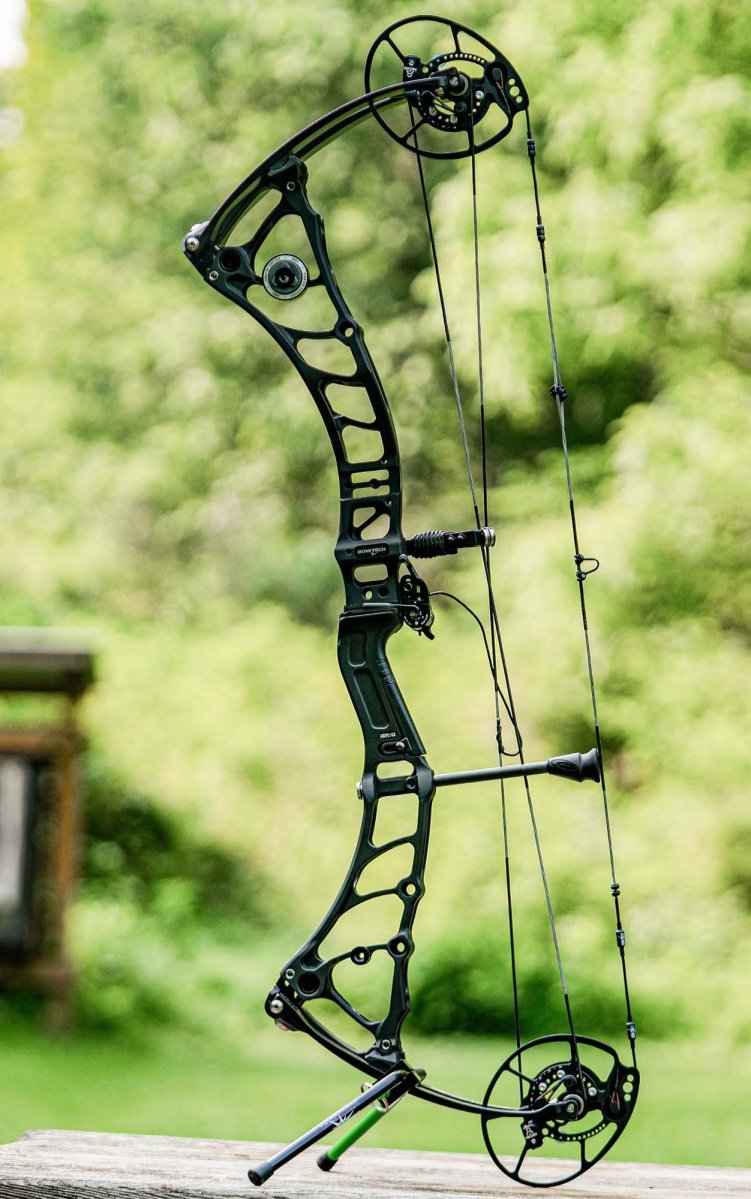
Photo by Derek Horner
See It
Specs
-
Price:
$1,999 -
Draw Length Range:
25 to 30 inches (.5-inch increments) -
Axle to Axle:
32 inches -
Brace Height:
6.19 inches -
Let Off:
80 percent -
Weight:
4.0 pounds (with QAD)
Features
-
Titanium screws -
Cerakote finish -
Magnesium alloy riser -
Deadlock, Timelock, and Griplock allow for tuning the bow without a bow press -
Centermass sight mount -
Integrate rest mounting -
Flip Disc: You can shoot the bow on “Comfort” for a smoother draw or “Performance” for more speed
Test Results
-
Group Average:
4.25 inches -
Speed:
282.4 fps (61.3 pounds, tested on the comfort setting) -
Score:
26.5
Tuning Notes
-
Center Shot:
13/16 inch -
Stock Serving Diameter:
0.127 inch -
Nocking Point Height:
Level

In past bow tests we had a build quality score, which wasn’t a separator among the top bows. So I replaced it with an innovation score to reward companies for bringing new technology to the market. The top scoring bow for innovation this year was the Virtue because of its new riser material and full suite of features.
The Virtue is made from a magnesium alloy that makes the bow exceptionally light — the lightest for its length we’ve tested. Magnesium isn’t a new material for bow risers and it has been used to make recurve and compound risers. The issue is that magnesium is a soft metal and much weaker than aluminum. Bowtech’s AeroMag magnesium successfully keeps the weight savings of magnesium while being rigid like an aluminum riser. It’s a feat of material science that brings a cool new riser to compound bows.

Bowtech is the ultimate bow for the tinkerer. You can move the cams, fine-tune timing, adjust draw length, and change the grip angle without touching a bow press or buying parts. As a tinkerer myself who has stripped out a lot of module screws, I love that Bowtech uses titanium and stainless steel screws, which don’t strip out as easily as the typical un-hardened metal ones.
There’s no denying Bowtech packed the Virtue with technology that’s beneficial to the end user, but the testers didn’t enjoy shooting it as much as some of the top finishers. It scored mediocre to low for its shooting characteristics and was toward the bottom of the pack for accuracy. One tester noted that they felt like they had to make perfect shots for the arrows to go in the middle.
Others felt like the bow shot best when weighed down with heavier stabilizers. One of the benefits of a lighter bow is that you can balance it with a longer stabilizer and a backbar while still maintaining a relatively light rig. The stabilizer bushing also unscrewed from the bow during testing. It’s an easy thing to fix, but that isn’t the build quality we like to see from a flagship bow.
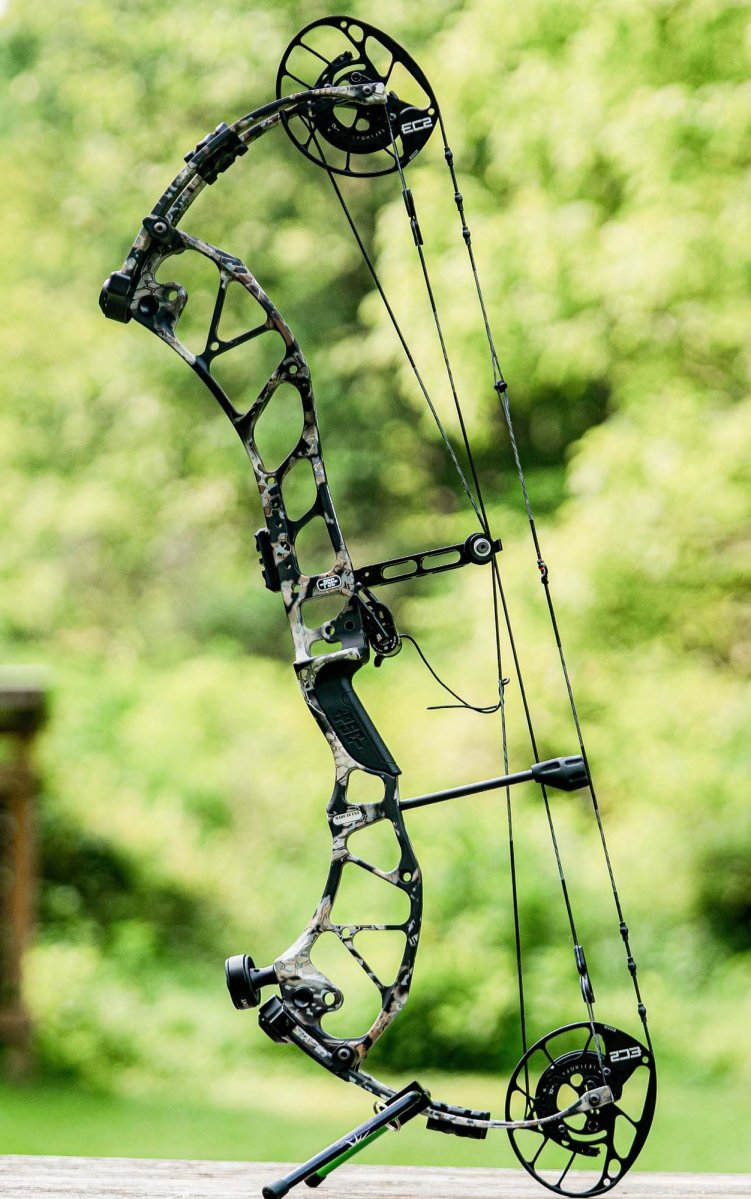
Photo by Derek Horner
See It
Specs
-
Price:
$1,400 -
Draw Length Range:
25 to 30.5 inches (.5-inch increments) -
Axle to Axle:
31.5 inches -
Brace Height:
6.5 inches -
Let Off:
80 to 90 percent -
Weight:
5.09 (with QAD)
Features
-
Full Draw Stability: Adds .25-inch of brace height for reduced torque -
EZ.220 cam spacers -
Hamskea COR and QAD Integrate rest mounting -
Picatinny sight mount
Test Results
-
Group Average:
3.35 inches -
Speed:
285.5 fps (59.1 pounds) -
Score:
24.6
Tuning Notes
-
Center Shot:
51/64 inch -
Stock Serving Diameter:
0.114 inch -
Nocking Point Height:
1/8-inch high
The PSE Carbon bows deservedly get all the attention, but the aluminum bows are shooters too. This year’s accuracy champ is the Decree, which beat out the Mach 33 by 0.02 inch and the Mathews Lift X by 0.31 inch. The Decree was also the second fastest bow and at the top of the pack for smoothness and post shot feel.

It has the same Full Draw Stability as the Mach 33. At full draw the dynamic brace height measures 6.75 inches and its static brace height is 6.5 inches. So you’re getting a little extra forgiveness and no speed penalty. Aside from the riser material, the biggest difference between the Mach 30 that won last year’s bow test and the Decree is about a $500 cheaper price tag. So if you like everything about the Mach bows, but the price, the Decree is one to look at.
The main drawback to the Decree versus its competition is the fact that it lacks a customizable grip, 0.25-inch draw length adjustment, and Allen-wrench-only tuning feature.
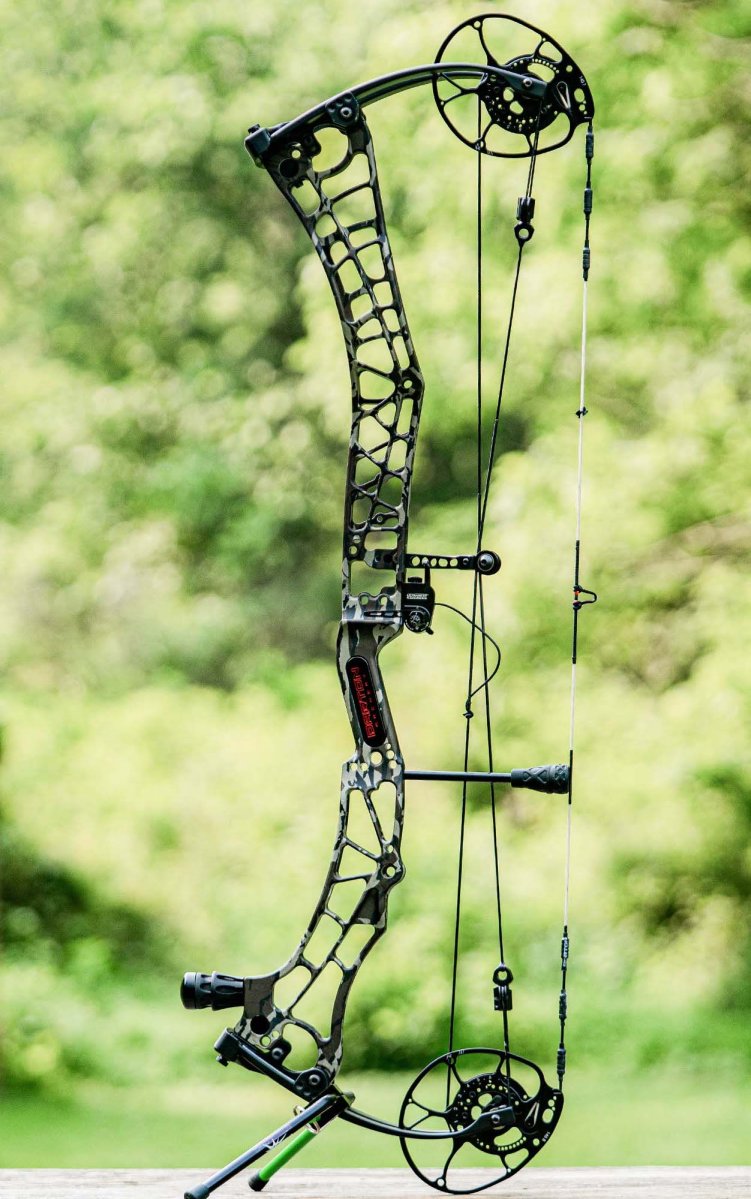
Photo by Derek Horner
See It
Specs
-
Price:
$1,250 -
Draw Length Range:
25.5 to 30.5 inches -
Axle to Axle:
33.187 inches -
Brace Height:
6.375 inches -
Let Off:
75 to 85 percent -
Weight:
5.1 pounds (with QAD)
Features
-
Perfect Tune: Allows for adjusting cam lean with just an Allen wrench -
Perfect Timing: Allows for fine tuning cam timing -
QAD Integrate and Hameskea COR rest mount -
Micro adjustable let off -
Optional speed mod available
Test Results
-
Group Average:
4.12 inches -
Speed:
279.7 fps (60.5 pounds) -
Score:
25.3
Tuning Notes
-
Center Shot:
25/32 inch -
Stock Serving Diameter:
0.121 -
Nocking Point Height:
1/16-inch high -
The riser is very thick and even with a spacer, a bolt-on QAD couldn’t adjust far enough left to get a proper center shot. Go with an Integrate or COR rest mount to alleviate any potential issues.
This year Darton introduced two new tuning features that make a bow mechanic’s job easier. The Perfect Tune system adjusts cam lean by turning a screw next to the limb bolt with an Allen wrench. It’s just as easy to use as Bowtech’s DeadLock or Elite’s S.E.T and it allows you to paper tune, bareshaft tune, or broadhead tune without a bow press.

Throwing new strings on a bow and getting the cams close to perfectly timed takes a few minutes. But it’s often the fine tuning of cam timing that can eat away your Saturday afternoon. I often have a bow that is an 1/8-inch of sync. If I add a half twist to one cam and it pushes the other cam out of time. Then it’s a matter of twisting yokes or loop strands. Guessing and checking until I finally find the right combo for even timing.
Darton solves that problem allowing you to micro tune your cam timing. You’ll just loosen a set screw on the Perfect Timing adjuster and then turn it as much as needed. Instead of being pigeonholed to a half or full twist in your cables you can now put in 1/100 of a twist if you need to. Not only does the Perfect Timing system save you time and headache, you can even experiment with putting your cams the tiniest bit out of sync to see if it improves your hold.

This bow is a shooter and received excellent scores for draw cycle, post shot, and back wall. While Reilly was conducting his Sequel accuracy testing, I remember him smiling ear to ear and saying “I like this bow.” The testers didn’t hate the Sequel’s grip, but they also didn’t love its shape. The bow is also on the heavy side for a 33-inch bow.
Grip gripes aside, the Sequel is one of the best values in flagship bows. It’s the least expensive bow we tested, but also one of the best performers and most feature packed. I’d call it a must-try for anyone who isn’t looking to spend Mach 33 money on their next bow.
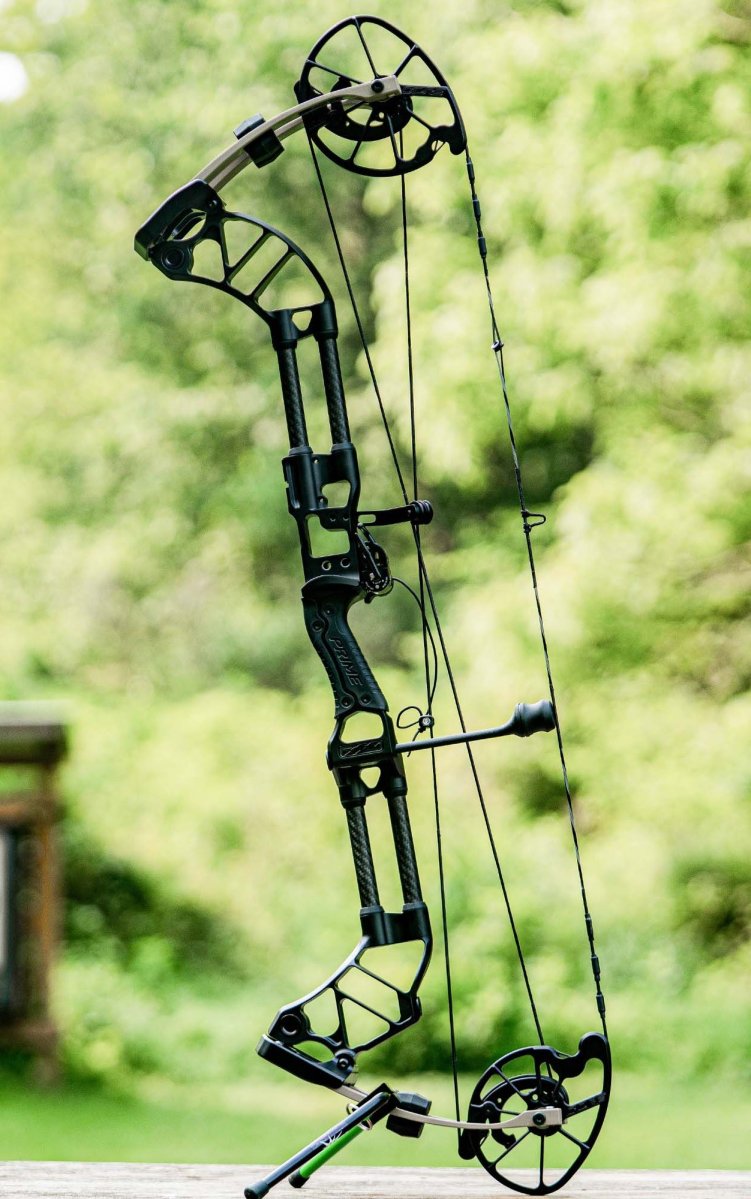
Photo by Derek Horner
See It
Specs
-
Price:
$1,595 -
Draw Length Range:
26.5 to 30.5 inches -
Axle to Axle:
34 inches -
Brace Height:
6.25 inches -
Let Off:
75 to 85 percent -
Weight:
4.3 pounds (with QAD)
Features
-
Riser made from carbon and aluminum for weight savings and rigidity -
Picatinny sight mount -
Draw length specific mods -
Free strings every two years for life -
QAD Integrate rest mounting -
Nano Grip: Insulates grip from cold aluminum riser -
Sherpalite integrated quiver
Test Results
-
Group Average:
4.31 inches -
Speed:
278.7 fps (60 pounds) -
Score:
23.9
Tuning Notes
-
Center Shot:
13/16 inch -
Nocking Point Height:
Level -
Stock Serving Diameter:
0.113 inch

The Form is one of the coolest looking compound bows I’ve seen in a very long time and it’s also one of the most innovative bows released this year. The heart of the Form is a completely new riser construction that uses aluminum and carbon fiber. The mixing of materials cuts weights while maintaining rigidity. The result is a light bow for its length. It’s about a half-pound lighter than the Hoyt RX-9 Ultra and just a touch heavier than the PSE Mach 35.

The Form was one of the smoothest drawing bows of the test. It averaged a score of 4 out of 5 in that category. Its force draw curve shows that smooth draw with a gradual climb up to peak weight and a slow slide into let off.

The testers rated the Prime grip average to good. So most people should be able to get along with it just fine. The interesting thing about the grip is that it’s insulated with a material called AeroGel, which is designed to make it warm to the touch even when the aluminum riser is freezing cold.
Nearly all carbon bows cost $1,800 to $2,000, but the Form costs $1,600. It also comes with a fantastic warranty. The original owner gets a new set of strings for free every two years. If you need a replacement part, they’ll ship it within 48 hours. The bow is covered for life for any manufacturing defects. You can also take your bow back to the shop within 6 months of purchase for a free tuning.

Photo by Derek Horner
See It
Specs
-
Price:
$1,259 -
Draw Length Range:
24.5 to 30 inches -
Axle to Axle:
29.5 inches -
Brace Height:
6 inches -
Let Off:
80 or 85 percent -
Weight:
4.2 pounds
Features
-
Limb Shift: Moves cams left or right with just a set of Allen wrenches -
Bond Grip: Swapable grips -
Integrate arrow rest mount -
Bridge-Lock sight and stabilizer mounting -
Shot Sense
Test Results
-
Group Average:
3.66 inches -
Speed:
288 fps (59.1 pounds) -
Score:
22.7
Tuning Notes
-
Center Shot:
13/16 inch -
Stock Serving Diameter:
0.120 inch -
Nocking Point Height:
Level

My favorite Mathews of all time is the 2019 Mathews Traverse. But it’s a very different bow than the Lift X. The Traverse is an easy drawing bow that feels lighter than its actual draw weight. The Lift X is more aggressive and all three of the testers didn’t like the draw cycle. The complaint about the draw cycle is that it has two areas that require effort — one at the start of the draw and one right before the cams roll over. You can see this in the draw force curve as a peak in the beginning of the draw cycle and another one just as the draw weight drops down.

The Lift X has that draw cycle because its cams are designed for speed. It was the fastest bow we tested this year and the trade off is less comfort in the draw and a shallower valley.
This is the second year in a row that Mathews came in second to PSE in the accuracy testing. It averaged about a 0.3-inch larger group than the two PSEs. The difference maker in the accuracy testing between the two brands was the consistency. The Mathews shot some very small groups under 3 inches but it also shot some over 4 inches. That inconsistency was partly the comfort at full draw and the stock Engage grip.
I’ve campaigned against the Engage grip for years and Mathews finally did something about it. You can now easily swap the Engage for different grip shapes. Of course, like all things Mathews, that feature comes at a cost. A new grip will run you $100.
The Mathews Lift X is still a bargain for a flagship bow, it’s more than $100 less than the PSE and Hoyt aluminum options. That price point, its rich features, and the Mathews brand loyalty will undoubtedly make the Lift X one of the best selling bows of the year.

Photo by Derek Horner
See It
Specs
-
Price:
$1,300 -
Draw Length Range:
25 to 30.5 inches -
Axle to Axle:
30 inches -
Brace Height:
6.875 inches -
Let Off:
70 to 90 percent -
Weight:
5.3 pounds (with QAD)
Features
-
Picatinny sight mount -
Hamskea COR and QAD Integrate arrow rest mounts -
S.E.T. for easy tuning with Allen wrenches -
¼-inch draw length adjustment -
Picatinny mounts for bow stand and other accessories
Test Results
-
Group Average:
4.5 inches -
Speed:
282.5 fps (60.5 pounds) -
Score:
22
Tuning Notes
-
Center Shot:
14/16 inch -
Stock Serving Diameter:
0.117 inch -
Nocking Point Height:
1/8 inch high
The Artus is a nimble bow with good speed. It has Elite’s S.E.T, new bipod attachment, adjustable let off, and 0.25-inch draw length adjustment. Testers liked the Artus’ back wall and post shot feel, although not as much as the Exalt. But it came up short in all other aspects.

It has an aggressive draw cycle to produce its solid speed numbers. The draw is typical of speed bows with an abrupt transition into the valley. The accuracy results were mixed with one tester saying he felt very accurate with the bow and the two others shot some of their worst groups.
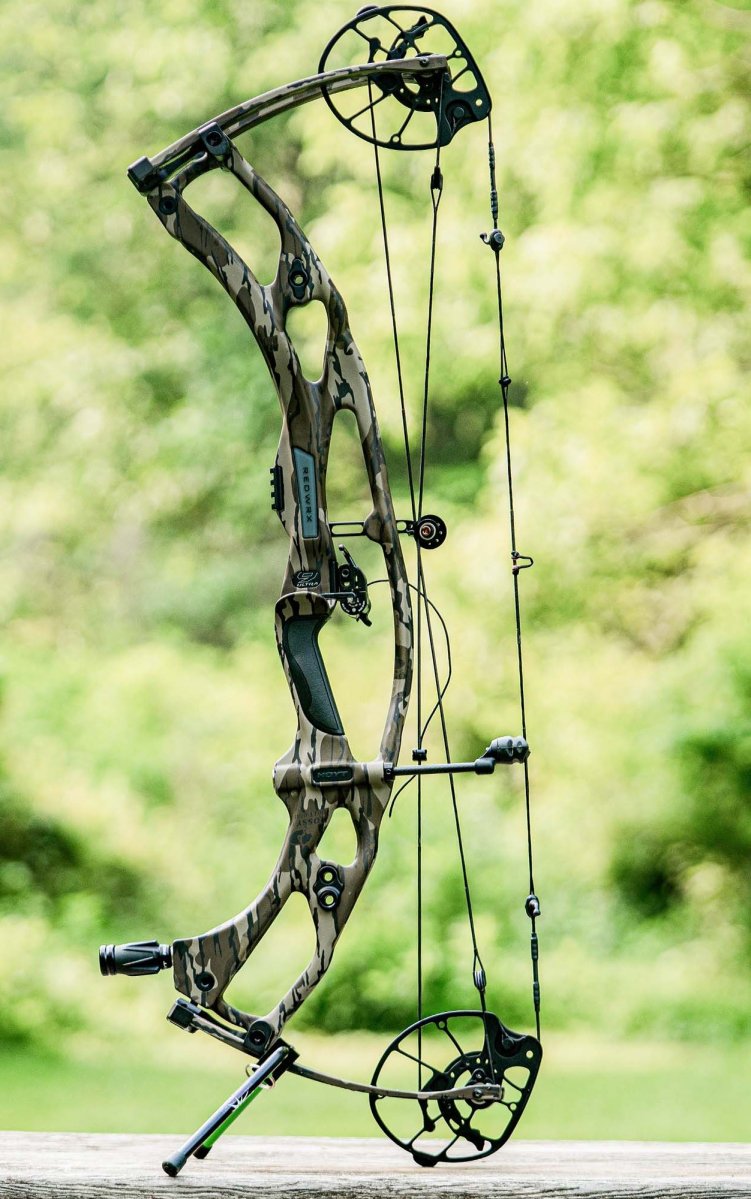
Photo by Derek Horner
See It
Specs
-
Price:
$2,050 -
Draw Length Range:
26 to 31 inches (1/4-inch adjustments) -
Axle to Axle:
33.5 inches -
Brace Height:
6.375 inches -
Let Off:
75 to 85 percent -
Weight:
4.7 pounds (with QAD)
Features
-
5 rotating mods, ¼-inch draw length adjustments -
Integrate arrow rest mount -
Picatinny sight mount -
Adjustable back wall feel
Test Results
-
Group Average:
4.56 inches -
Speed:
279 (59.2 fps) -
Score:
20.3
Tuning Notes
-
Center Shot:
25/32 inch -
Stock Serving Diameter:
0.115 -
Nocking Point Height:
3/16 high
This year Hoyt released a new limb design and a new cam. The new cam kept a lot of the smooth draw we liked from the RX-8, but added some speed. We got 274 fps from the RX-8 last year and 279 fps out of the RX-9. A 5 fps bump without giving up much on the draw cycle is a win.

Hoyt accomplishes that speed increase by narrowing the adjustability of their mods. Each cam module has 0.75-inch of adjustment in 0.25-inch increments. That gives you enough room to fine tune your draw length, but you can’t quickly adjust a bow from 30 inches to 26 inches like you can with a rotating mod. Another feature of the new cam is the ability to customize the feel of the back wall. You can go from a hard stop to a super hard stop on the back wall by flipping the modules.
Integrated bow pods have gotten more popular and Hoyt bows use their Go Stix 2.0. When you use a bow pod though your cam still touches the ground and you can get dirt in your string tracks. Hoyt has a smart solution to that problem and they’ve built in a rubber piece on the cam that lifts it up just slightly to prevent damage.

Hoyt bows are known for their durability. They’ve published videos of their dry fire testing and their carbon bows being run over by a truck as proof of that durability. The new limbs are designed to be more durable and reduce torque.
We liked all those features, but the RX-9 was just OK in terms of shooting characteristics and did the worst in the accuracy testing. It’s also the most expensive hunting bow on the market. The Hoyt aluminum hunting bows are more reasonably priced and would be my choice if I was shopping for a Hoyt.
Bow Score Sheets

How We Tested the Best Compound Bows
Set Up
All bows were set to 60 pounds (+/- 1 pound). We set bows at 29.5 inches of draw length and measured exact draw weight to provide context for the bow’s speed.
We timed the cams, set the centershot to the standard 13/16 inch, and set the nocking point height level. Then we paper tuned to a bullet hole to make sure we were doing the speed and accuracy testing with a tuned bow.
Scoring
After the test team finished shooting all the bows, they scored them on six criteria. Each was scored on a 1 to 5 point scale. A score of 5 meant the bow was the best, or tied for the best, in a particular category. A 3 means a bow is average. A 1 is a poor performer compared to the other bows.
- Innovation: New technology in compound bows receive a high score, the same bow as last year with a slight modification gets a low score.
- Features: Tuning adjustments, rest/sight mounting, draw length adjustment, and customizable grips are all things we look for
- Back Wall: How does the back wall and valley feel?
- Draw Cycle: Is the draw smooth or harsh?
- Grip: Is it comfortable and does it promote consistent hand placement?
- Post Shot: Does the bow have vibration and noise?
Accuracy

Three testers shot a total of 324 arrows over two days to gather accuracy data. The testers were allowed to adjust stabilizers on the bows to suit their personal preferences. Other than that, the bows were set up identically.
The test team gave me plenty of grief for going from a five-arrow group to a six-arrow group. While it meant the groups would be larger than last year, it also created more separation in the field and we were really able to see which bows were the most forgiving.
The accuracy test is telling because a bow must shoot well for three different archers to earn a small group average.
Speed
We shot Easton 5.0 arrows in a 350 spine cut to 29 inches with a 100-grain field point. The arrows weighed 395 grains overall. Each bow’s exact draw weight is listed along with its speed in the test results section.
We used a Garmin Xero C1 chronograph to measure three shots from each bow. We then averaged those three recorded speeds for the final spec. Because everything from a bow’s tune to the weight of the peep can affect a bow’s speed, the speeds listed are meant to provide reference points, not the final word on a bow’s speed. It’s also important to note that all of today’s flagship bows are pretty fast, but what’s impressive to us is when bows are easy to draw and still shoot fast.
Draw Force Curves

We put bows in an LCA Draw Board and used an LCA Bow Scale 3.0 to measure draw weight at every inch of draw length from brace to the back wall. The weights were plotted on a line graph to depict each bow’s draw cycle. Bows that ease into their peak weight and ease into let off ultimately feel smooth. A bow that quickly gets to the peak weight and sharply drops off is an aggressive draw cycle.
Gear We Used for Testing

Chronograph: Garmin Xero C1
The Garmin Xero C1 uses doppler radar to track a projectile and measure its speed. We chose it because it’s the best chronograph available and it provides consistent readings no matter the lighting conditions.
Bow Sight: HHA NYTRX

The NYTRX tied for first place in our best bow sights buying guide and we chose it for all the reasons that make it one of our top recommendations. It’s easy to adjust, has a bright pin, and can stand up to the abuse the sights take during testing.
Arrows: Easton 5.0
The Easton 5.0 is the hot arrow this year and our pick for the best hunting arrow. Its good weight, solid components, and tight specifications made it the perfect arrow for accuracy testing this year’s top bows.
Arrow Rest: QAD Ultrarest
The QAD Ultrarest won best overall in our best arrow rest review. So it was an easy pick to be our arrow rest of choice for the bow test. It offered easy setup, reliability, and accuracy.
Stabilizers
Front and rear stabilizers help refine your pin float and we used a variety of options for accuracy testing. They included the Axcel Antler Ridge, Redline RL-1, Bee Stingers, and AAE Hot Rodz.
Other Tools Used
The Test Team

P.J. Reilly: A longtime bow reviewer and video host for Lancaster Archery Supply. Reilly also reviews bows for LAS and has bowhunted everything from whitetails to musk ox.
Alex Robinson: Outdoor Life‘s Editor-in-Chief, bow test veteran, and workaday bowhunter.
Connor Kaufhold: The youngest member of the test team, but also the most experienced competitive archer. Kaufhold is a collegiate all-american in recurve, compound, and bowhunter divisions. He works at his family business, Lancaster Archery Supply, and enjoys bowhunting whitetails.
Scott Einsmann: Outdoor Life Executive Gear Editor, test organizer, former archery coach, and lifelong archery nerd.
The Upshot

The compound bow market desperately needed a spark of innovation to push it forward. This year we finally got it. Although, the innovation isn’t coming from the big three names in bowhunting (PSE, Hoyt, and Mathews). It’s coming from smaller bow companies like Prime and Darton. These smaller brands are doing new things that solve problems for bowhunters like Prime’s carbon and aluminum riser that cuts weight and cost for the consumer over a carbon bow. The new Darton tuning systems makes the job of a home bow mechanic far simpler and lowers the barrier of entry for DIY bow tuning.
Bowtech is the most innovative of the big bow companies. They are the ones that started the trend of including features for the home bow shop. We now see versions of their DeadShift in other big name bow brand lineups. But their new riser material is a far bigger deal. We haven’t seen bows made out of a new material since carbon bows came out in the late 90s.
If you’re stuck on brand loyalty — I’m looking at you Mathews fans — you’re missing out on a lot of cool new bows. So as you’re trying out new bows this year, give one of the little guys a chance alongside your favorite big names.
Read the full article here

